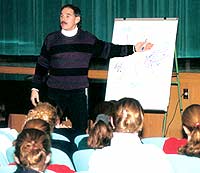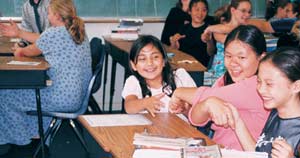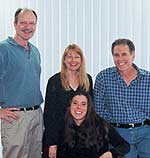
|

|
|
|
|
|
|
|
|
| |||||||||||||||||||||||||||||||||||||||||||||||||||||||||||||||||||||||||||||||||||||||
|
A study from the Federal Substance Abuse and Mental Health Services Administration released in March 2002 reports that Los Angeles has the nation’s highest drug-related deaths — 1,192 of them in the year 2000 alone (the most recent annual statistics available). Heroin, cocaine and alcohol accounted for 40% of the deaths, mostly in individuals age 25 or above. And like Dee Dee Ramone and many others before him, most if not all of those who die from drugs started their abuse and addiction early. Currently, every year in the United States over 2.9 million people start using illegal drugs. The vast majority of them are children. If only 10 percent of them reach a point of needing professional help, simple math demonstrates that there are nowhere near enough resources to do the job. And even for those who do make it to packed rehab programs, the results are seldom lasting, and a true cure is rare. It is facts like these that drive Tony Bylsma, director of Narconon Drug Prevention and Education, to reach out to more and more children in the greater Los Angeles area each year. Using drug education lectures that have been refined continually since 1979, Bylsma and other lecturers are proving that with a solid education in the effects of drugs, kids can make sane and sensible decisions that will keep them from abusing. “You’re the first person that actually made me think and see the real side of drugs,” said one L.A. high school student after a Narconon drug education lecture. “You’re not like all the other people who I’ve heard speak. They all say, ‘Don’t do drugs. Drugs are bad.’ But you said, ‘Make your own decisions.’ For the first time ever, I listened.” “I don’t think ecstasy is a good idea anymore,” wrote a student from Cleveland High School. “I will always have [the lecture] in the back of my mind.” School administrators and teachers have also noted the difference, at times remarkable, in students after the lectures. “The students in his [Bylsma’s] classes universally reported that they had, in fact, definitely learned things they had not previously known,” said one Los Angeles school principal. “He was not viewed as ‘another adult lecturing,’ and several students reported a desire to give up their drug use, or reaffirmed their commitment not to use.” Narconon lectures are used in classrooms in other U.S. cities, including throughout New England, where the leading drug education specialist in the Narconon network, Bobby Wiggins, has reached hundreds of thousands of students. Reduction of drug use of as much as 70 percent has been reported in some schools as a result of the Narconon drug education lectures. In response to demand, Wiggins has trained up scores of other lecturers, like Bylsma, and recorded his own lectures onto video. The drug education program has now reached close to a million students. Education versus Fear Narconon drug education draws on a vast amount of experience and knowledge. The Narconon drug rehabilitation program, which uses the research and discoveries of
The Narconon network undertook broad drug education in the 1970s, after observing that most attempts at prevention have little to do with education, but more with fear. “Education” was thought by some to convey that children and adolescents are not yet responsible enough to make good decisions where drugs are concerned. Thus in many cases, it consists of grotesque pictures of burned-out, shriveled lungs, or arms torn up by needles. According to Bylsma, there is a huge liability in trying to influence kids away from drugs with fear tactics. “When they finally meet someone who’s using a drug they’ve heard horror stories about, and he doesn’t look anything like the pictures, it tends to invalidate all warnings,” he said. Most past drug education approaches, he said, tried to instill an idea or thought into the child’s consciousness — with or without his consent — to motivate him to act in a desired way. “It’s the same principle used in advertising. There’s a trend toward not even talking about the product, but just showing it in a way that makes it seem desirable,” Bylsma said. “When Britney Spears sells Pepsi to the masses, the point isn’t that it tastes better than the competition, or that it is cheaper or better for you. She just holds the can up, dances around it and makes sure that you see how good it looks in her hand. A can of 7-UP would look just as good — or even motor oil. “Attempts today to instill anti-drug images into young minds are overpowered by the massive promotion and advertising that occurs for drug products in every medium. Drugs are in classrooms, and in medicine cabinets at home. They pervade all forms of media. A child can barely watch TV or look at a magazine for more than a few minutes without being told how to relieve aches, indigestion, obesity and depression with drugs.” Bylsma said that an anti-drug message that tries to use the same tactics in the face of the onslaught of pro-drug communication in society gets lost. Further, drug advertising attaches itself to images of fun, or being able to perform well in life. Messages against drugs are normally attached to images of fear, decay and damage. “Which would kids rather pay attention to?” said Bylsma, who noted that kids also get unnerved when programs use fear, as they resent the attempt to make their decision for them. It also spurs some to rebel and go the other directions. But outcomes from scare tactic drug education have led to the belief by many that drug prevention and education is ineffective in stemming the tide of drug abuse. “Only ineffective education gets an ineffective result,” Bylsma said.
In 1979, two of Narconon’s staff in Los Angeles determined that the only viable, long-term answer to the drug trend was education and prevention. They drew on the extensive experience of Narconon executives and counselors and sifted through all the worthwhile references on drugs they could find, including all the writings of Then as well as now, Narconon drug education takes a unique approach. It recognizes that students are already being covertly convinced to consume drugs, through various channels in society. And it presumes that students are capable of rational, independent decisions. Each lecture begins with a clear message to the students that the purpose of the talk is education, and the decision making is up to them. After first developing the program in 1979, Narconon executives sent a letter out to all L.A. area schools. They got back 200 responses, and from that point they began delivering 300 to 500 drug education lectures per year in this area alone. In January 1981, the Narconon office in Los Angeles called and brought together the directors of other Narconon offices in the United States for a seminar on how to deliver effective drug education to children. Tony Bylsma was director of Narconon St. Louis at the time, and was one of those called. He came out to L.A., learned the drug education program and took it home. Using what he knew over the next few years, he delivered the lectures to more than 100,000 people, the majority of them students. After a long hiatus, in 1999 he again determined to approach the drug problem from the standpoint of education and this time, he would make it his mainline career. In 2000, after training in Boston under Narconon top drug education expert, Bobby Wiggins, Bylsma moved to Los Angeles and established Narconon Drug Prevention and Education. He and program director Sigal Adini now work out of a storefront office in Glendale, arranging and delivering lectures at Southland schools. Each week they reach an average of 300 students, mostly high school age. Bylsma spends most of his weekdays at the schools, while Adini handles the promotion and scheduling and also delivers some of the talks. Bylsma sometimes calls on another veteran Narconon speaker from the Narconon center in Newport Beach, Gerry Marshall, to meet the demand. To reach even more youth, lectures have been videotaped by an associated group, Friends of Narconon, and are distributed nationwide.
Over the years the program has been augmented and refined based on survey results from students. It includes a number of different lectures focusing on different aspects of drug abuse — effects on the body, the mind, the individual himself and his life and future, as well as lectures on specific drugs, such as marijuana, ecstasy and LSD. One lecture is on drugs and alcohol in the media, another talk is on achieving goals — which in addition to demonstrating drugs’ ill effects on life achievement, provides the students with tools to help them set and achieve their aims. “An important part of drug education is to let students know that there are other and better tools than drugs for handling life and getting some respite from it,” Bylsma said. Each lecture opens with some ground rules. “I’m not going to tell you what to do and I’m not going to try to scare you,” Bylsma tells them. The educational part of each talk begins with the definition of a drug: A drug is any substance you put in the body that is not a food and that changes the way the body or the mind is working. He explains, per the researches of The body’s first response to a poison is to speed up and try to get rid of it. Thus the first effect of a small amount of any drug is to act as a stimulant. If more of the drug is consumed, it begins to act as a depressant. The body is beginning to be overwhelmed and slows down to try to minimize the effect of the poison. If still more of the drug is consumed, the depressant effect can lead to a coma and eventually to the third physical response, which is death. Building from these basics, Bylsma’s lectures differ, contingent on whether he is addressing their effect on the body, the mind or the individual himself. Depending on which lecture he’s giving, he backs it up with stories from his own personal experience. Having worked in the Narconon drug rehabilitation program for many years, he has seen the effects of every type of substance. Bylsma also has a drug history of his own, and having gotten off drugs through the Narconon program, he has plenty of stories to tell. After each lecture, students routinely have questions, and Bylsma stays to answer them. He recalls one time after a lecture that went particularly long, an impressed teacher told him, “They chased out the last guest speaker. He left after about 20 minutes.” His talks generate so much interest that it is not unusual for students to give up a break to stay and hear more. “Kids are in mystery to some degree about drugs. You fill in the blanks, and they’re very interested. And if a kid understands something, he’s less likely to have to experiment with it to know what it is,” Bylsma said. “Once again, you have ‘wowed’ the students with your very powerful presentation about the dangers of drug use,” wrote a school counselor in an assessment of Bylsma’s lectures. “During each of your talks, I was impressed with how attentive the classes were — at times I could even hear the proverbial pin dropping. The details you provide, humor you interject and the personal story you share have a very profound effect on our young people.” In a number of cases, the lectures have helped students caught in the dilemma of having family members, even parents, who take drugs. “These kids have a particularly confusing time of it, trying to sort out right from wrong. Learning facts about drugs and drug use helps them to understand — to sort that out,” said Bylsma.
After each lecture, the students are given a survey, to be filled out anonymously, asking what they thought of the lecture, whether it changed the way they think about drugs and how they could use what they learned. Almost one for one they say their thoughts about drugs changed. Teachers, counselors and school administrators are also asked for their review, and routinely give high praise for the lectures. “I, personally, was very moved by the presentation. I also learned new information along with our students,” said one Los Angeles school principal. “I believe, after hearing the presentation myself, that this program can truly save lives as well as help people make decisions that will lead them toward productive lives.” As Bylsma describes it, “Instead of concentrating on ‘stopping’ drug abuse, the Narconon drug education program puts children into control as far as drugs are concerned. Children and teenagers are quite capable of understanding and making their own sensible, informed decisions.” The Narconon drug education plan is to keep going until they are reaching all of the Southland schools and, nationally, the 2.9 million children that have been starting on drugs each year. “Bit by bit, we’re chipping away at the drug culture. We’re aiming toward a point where the entire society will know enough to keep off drugs,” concludes Bylsma. “It’s the only way we are ever going to change the trend. It’s the only way that’s ever going to happen.” For more information: www.addictionca.com
|
|
|
|
|
|
|
|
|
|
|
|
|
| Previous | Scientology Glossary | Contents | Next | |
| Your view | Scientology Related Sites | Bookstore | Church of Scientology Freedom Magazine |
|
|
|
|
|
||||||||||||||||||||||||||||||||||||||||||||||||||||||||||||||||||||
Supported Sites
Scientology Groups · Reviews for "The Church of Scientology" · Scientology: The Doctrine of Clarity · Religious Tolerance: Scientology · Description of the Scientology Religion · Scientology (CESNUR) · Scientology · Scientology Handbook · Scientology Religion · What is Scientology?






